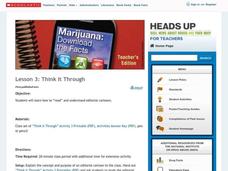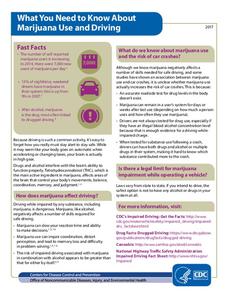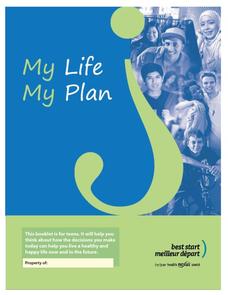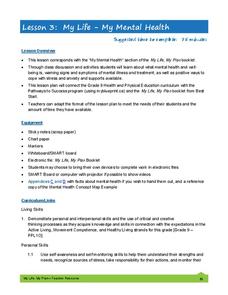National Institute on Drug Abuse
The Brain's Response to Drugs
Marijuana affects the brain differently than inhalants, which have a different effect than opioids. Elementary and middle school classes read about these drugs as well as nicotine, methamphetamine, hallucinogens, and steroids before...
Scholastic
Stress and Drug Abuse
Young scholars identify the different causes of stress. In this health science lesson plan, learners find the connection between stress and drug abuse. They discuss about the different kinds of stress they experience everyday.
Generation Rx
My Generation Rx: Minute Activities
Want to discuss the prevalence of prescription drug abuse among teenagers, but running out of class time? A series of short, straightforward activities address topics such as sharing prescription drugs, coping mechanisms for stress, and...
Scholastic
Heads Up: Real News About Drugs and Your Body
What's the difference between medical marijuana and marijuana bought on the street? Not much. High schoolers learn more about marijuana with an informational booklet that focuses on the medical uses of THC, how marijuana affects the...
Nemours KidsHealth
Drugs: Grades 3-5
Two lessons take a close look at drug prevention. The first lesson, split into two sessions, challenges learners to gather information from an article, answer questions, then create a poster that encourages others to stay away from...
ProCon
Drug Use in Sports
The ancient Greeks used performance enhancing drugs, such as opium juice, when they participated in the original Olympic Games. Pupils research a website with debate topics to decide if athletes' use of such drugs in modern sports is...
Council for the Curriculum, Examinations and Assessment
Drugs Awareness
Peer pressure can lead to dangerous activities for the eighth graders in your class. Prepare them for the tough conversations in the years ahead with a set of lessons about drugs and their consequences on users' lives.
Scholastic
Consider the Source
Who is more trustworthy when it comes to marijuana: a high school student, or The National Institute on Drug Abuse? Sources matter when reading informational text. Help teenagers discern which facts are true with an activity that focuses...
Scholastic
Opioids and the Overdose Epidemic
Learn about the opioid and overdose epidemic in America with an article that explains what opioids are, how they are used, and how they are abused. Learners discover the death rates associated with opioid overdoses and other factors that...
Scholastic
Think it Through
What does the media tell the teenagers about using marijuana? Help class members decipher what they are being told about drug use with a lesson on editorial cartoons, subliminal messages, and critical thinking skills.
PBS
Opioids in Our Community—Middle School
How do opioids affect the lives of families and individuals within a community? Scholars explore the topic with a series of informative, thought-provoking videos. They also complete worksheets and discuss the effects of the opioid...
Scholastic
The Science of Marijuana—How THC Affects the Brain
Marijuana can affect every part of a user's life—starting with the delicate nervous centers of the brain. An informative article and worksheet prompt teenagers to learn more about how the THC found in most forms of marijuana can...
Scholastic
Marijuana: Perception of Harm vs. Use
Many teenagers don't believe that marijuana is harmful, but if they do, it affects whether they use it or not. Analyze the relationship between what high school seniors believe about marijuana and their tendency to use it with a reading...
Centers for Disease Control and Prevention
What You Need to Know about Marijuana Use and Driving
Research indicates that marijuana can negatively affect coordination and judgment, making it dangerous to drive while under the influence. But does it increase the risk of car crashes? An informative fact sheet describes the ways...
Centers for Disease Control and Prevention
What Parents Need to Know About Marijuana Use and Teens
The teenage years find adolescents yearning for independence—and often isolating their parents from their everyday lives. Educate parents on the warning signs of marijuana use, including its effects on the brain and the likelihood of...
Scholastic
Marijuana: Breaking Down the Buzz
Teenagers get the real information about marijuana use based on the history of tobacco legislation and research. As they read an educational passage about marijuana laws, science, and changing attitudes, they address their preconceptions...
Safe Teens
Teen Game Plan
Don't let the teenagers in your class begin their life without a plan. A brief but inclusive booklet takes high schoolers thorough various aspects of their lives, including financial literacy, vaccinations, and sexual health, and lets...
Advocates for Youth
How Can I Take Care of My Health?
Life is all about choices, and a healthy life tends to involve a lot of healthy choices. Guide teenagers toward a life full of nutritious food, regular exercise, and responsible decisions with a series of lessons on healthy habits for...
Scholastic
Marijuana: Breaking Down the Buzz
There are a lot of myths surrounding marijuana. Read a passage that clarifies the dangers of teens smoking marijuana, its harmful effects on the development of the brain, and the possible correlation of cigarette smoking to marijuana...
Centers for Disease Control and Prevention
Current Cigarette Smoking Among Adults Infographic
Adult cigarette smoking has decreased in recent years, but it is still the number one cause of preventable disease and death in America. An infographic breaks cigarette smoking down by education level, geographical region, gender, race,...
Centers for Disease Control and Prevention
What You Need to Know about Marijuana Use and Pregnancy
Some people believe that using marijuana during pregnancy is safer than smoking tobacco, but studies show several negative impacts on babies whose mothers used marijuana while they were pregnant. Use a fact sheet to educate learners...
Hastings Prince Edward Public Health
My Life My Plan
Being a teenager is harder today than it's ever been. Guide high schoolers through the last few years before adulthood with a resource that encourages them to reflect on their lives and passions, and to make a healthy plan going forward.
Hastings Prince Edward Public Health
My Life—My Mental Health
Between peer pressure, an onslaught of hormones, and brand new responsibilities, the teenage years can be emotionally volatile. Equip young adults with coping mechanisms and a safe place to discuss their feelings with a guided lesson...
Delaware Health and Social Services
Set Your Mind, Set Your Goals
Becoming a woman can be overwhelming for girls. An educational resource assists female learners in setting goals for their reproductive choices, physical health, and emotional and mental well-being.
Other popular searches
- Drug Abuse Posters
- Drug Abuse Lesson Plans
- Alcohol and Drug Abuse
- Drug Abuse Prevention
- Prescription Drug Abuse
- Effects of Drug Abuse
- Drug Abuse Play
- Drug Abuse Projects
- Drug Abuse Survey
- Drug Abuse and Prevention
- Drug Abuse Factors
- World Drug Abuse

























